(Undo revision 1616155 by 71.88.45.103 (talk) - MA:CANON - "Star Trek: Online" Dyson sphere would only be considered apocrypha) |
Renegade54 (talk | contribs) m (formatting, linkfix) |
||
| (19 intermediate revisions by 6 users not shown) | |||
| Line 1: | Line 1: | ||
{{sidebar planet| |
{{sidebar planet| |
||
Name= "Dyson Sphere" |
Name= "Dyson Sphere" |
||
| − | | imageOrbital= dysonsphere.jpg |
+ | | imageOrbital= dysonsphere HD.jpg |
| imageSurface= Dyson sphere interior.jpg |
| imageSurface= Dyson sphere interior.jpg |
||
| Class= [[Class M|M]] |
| Class= [[Class M|M]] |
||
| Line 12: | Line 12: | ||
A '''Dyson sphere''' was a colossal spherical structure constructed around a [[star]], completely surrounding it. The interior of the sphere would absorb the entire [[energy]] output of that star, allowing for [[lifeform]]s to live on the interior surface almost indefinitely. Such a structure was theorized by [[20th century]] [[physics|physicist]] [[Freeman Dyson]] in the late [[1950s]]. |
A '''Dyson sphere''' was a colossal spherical structure constructed around a [[star]], completely surrounding it. The interior of the sphere would absorb the entire [[energy]] output of that star, allowing for [[lifeform]]s to live on the interior surface almost indefinitely. Such a structure was theorized by [[20th century]] [[physics|physicist]] [[Freeman Dyson]] in the late [[1950s]]. |
||
| − | [[File:Dyson sphere exterior.jpg|thumb|left|The ''Enterprise'' in orbit around the sphere]] |
+ | [[File:Dyson sphere exterior HD.jpg|thumb|left|The ''Enterprise'' in orbit around the sphere]] |
| − | For the interior of a Dyson sphere to be habitable to most [[humanoid]] lifeforms, the radius of the sphere must be such that habitable temperatures ([[Celsius|5 – 30 °C]]) are maintained. The radius would therefore depend on the size and the energy output of the star around which the sphere would be constructed; if a Dyson sphere were to be constructed around the [[Earth]]'s [[Sol|sun]], the radius would have to be approximately one [[astronomical unit]]. At such a radius, the interior surface area would be about |
+ | For the interior of a Dyson sphere to be habitable to most [[humanoid]] lifeforms, the {{dis|radius|geometry}} of the sphere must be such that habitable temperatures ([[Celsius|5 – 30 °C]]) are maintained. The radius would therefore depend on the size and the energy output of the star around which the sphere would be constructed; if a Dyson sphere were to be constructed around the [[Earth]]'s [[Sol|sun]], the radius would have to be approximately one [[astronomical unit]]. At such a radius, the interior surface area would be about 2.8 {{exp|17}} [[Kilometer per hour|km]]<sup>2 </sup> (1.1 {{exp|17}} mi<sup>2</sup>), or 550 million times the entire surface area of the [[planet]] Earth. Such a surface area could easily support the lives of many quadrillions (1 {{exp|15}}) of beings. |
Unsurprisingly, due to the almost immeasurable amounts of effort, resources and time required to construct such an immense structure, only one Dyson sphere has ever been discovered. This particular sphere encased a [[G-type star]] and had a diameter of 200 million kilometers, giving it an internal surface area of approximately 250 million [[Class M|M-class]] planets. As no radiant sunlight or [[solar wind]] escaped from the sphere, starships were not able to detect it until they were almost on top of it. As a result, the {{USS|Jenolan}} [[crash landing|crashed]] onto it in [[2294]] after being pulled in by the sphere's immense [[gravity well]] while ''en route'' to the [[Norpin colony]]. In [[2369]], the {{USS|Enterprise|NCC-1701-D|-D}} discovered the ''Jenolan'' and investigated the sphere. The sphere was deserted because the star around which it was constructed was highly unstable. ({{TNG|Relics}}) |
Unsurprisingly, due to the almost immeasurable amounts of effort, resources and time required to construct such an immense structure, only one Dyson sphere has ever been discovered. This particular sphere encased a [[G-type star]] and had a diameter of 200 million kilometers, giving it an internal surface area of approximately 250 million [[Class M|M-class]] planets. As no radiant sunlight or [[solar wind]] escaped from the sphere, starships were not able to detect it until they were almost on top of it. As a result, the {{USS|Jenolan}} [[crash landing|crashed]] onto it in [[2294]] after being pulled in by the sphere's immense [[gravity well]] while ''en route'' to the [[Norpin colony]]. In [[2369]], the {{USS|Enterprise|NCC-1701-D|-D}} discovered the ''Jenolan'' and investigated the sphere. The sphere was deserted because the star around which it was constructed was highly unstable. ({{TNG|Relics}}) |
||
| Line 20: | Line 20: | ||
=== Background === |
=== Background === |
||
[[File:Dyson Sphere graphic.jpg|thumb|left|A graphic of a Dyson sphere]] |
[[File:Dyson Sphere graphic.jpg|thumb|left|A graphic of a Dyson sphere]] |
||
| − | Technically speaking, the episode showed a Dyson ''shell'' rather than a Dyson sphere. A Dyson |
+ | Technically speaking, the episode showed a Dyson ''shell'' rather than a Dyson sphere. A Dyson sphere – sometimes called a Dyson "swarm" – consists of a series of satellites (or statites) orbiting a star which capture a large portion of its energy output and then transmit that energy to another location (e.g., a planet in the star system), or are themselves space habitats. |
| − | The |
+ | The Dyson sphere was named after scientist {{w|Freeman Dyson}}, who envisioned a {{w|Dyson sphere|real-world postulate}} in 1959, although the actual sphere that Dyson theorized was not a solid object like the one visualized in the episode. Dyson himself, who himself never took his idea too seriously, said in a later interview that, while the science behind it was "nonsense", as TV viewer he enjoyed the episode, [http://www.meaningoflife.tv/transcript.php?speaker=dyson] More specifically, he called his theory a "joke." About "Relics", Dyson said: "''Actually it was sort of fun to watch it. It's all nonsense, but it's quite a good piece of cinema.''" [http://www.meaningoflife.tv/video.php?speaker=dyson&topic=complete] In the same interview, he said that "Stapledon sphere" would be a more appropriate name, in honor of {{w|Olaf Stapledon}}, whose depiction of such an object in his 1937 novel ''{{w|Star Maker}}'' inspired young Dyson to look into the theory. |
A Dyson shell would retain all energy produced by the star, and would somehow have to radiate much of this into space to maintain a habitable surface temperature. One possible way of conserving such vast quantities of energy without emitting any visible radiation (as seen on-screen) would be to convert all the energy to mass - essentially using a [[replicator]]-like technology to create the many, many, many planets' worth of matter necessary to construct the whole sphere. Another possible way of disposing of such vast quantities of energy without emitting any visible radiation (as seen on-screen) would be to create a colossal gravitational field. If this was the case, it would explain why the ''Enterprise'' was jolted suddenly upon leaving warp, and possibly why the ''Jenolan''{{'}}s distress call went undetected until the ''Enterprise'' passed within a very short distance. |
A Dyson shell would retain all energy produced by the star, and would somehow have to radiate much of this into space to maintain a habitable surface temperature. One possible way of conserving such vast quantities of energy without emitting any visible radiation (as seen on-screen) would be to convert all the energy to mass - essentially using a [[replicator]]-like technology to create the many, many, many planets' worth of matter necessary to construct the whole sphere. Another possible way of disposing of such vast quantities of energy without emitting any visible radiation (as seen on-screen) would be to create a colossal gravitational field. If this was the case, it would explain why the ''Enterprise'' was jolted suddenly upon leaving warp, and possibly why the ''Jenolan''{{'}}s distress call went undetected until the ''Enterprise'' passed within a very short distance. |
||
| + | |||
| + | ===Story premise=== |
||
| + | The concept of the Dyson sphere as a B-story premise, had actually already been circulating among the writing staff for years, but until then the opportunity has never arisen to utilize the notion, "''It was something that we were trying to put in for a long time and it became a standing joke.''", noted episode Writer [[Ronald D. Moore]]. Once "Relics" came up the opportunity finally afforded itself and the episode's Science Consultant [[Naren Shankar]] went to work to beef out the concept, "''I originally thought the interesting thing would be to make it a partially complete Dyson's Sphere. It ended up being a completed Dyson's Sphere that was uninhabited. When Ron had written about the Dyson's Sphere in the teaser, he wrote "tech" and I gave him the numbers for the size of it. He was shocked that it was so big. It was like the equivalent of four million earths. It's huge. If you build something the size of the sun's orbit, you're talking about a sphere with a diameter of two hundred million miles.''" (''[[Cinefantastique]]'', Vol. 24, issue 3/4, p. 27) |
||
===Dyson Sphere maquettes=== |
===Dyson Sphere maquettes=== |
||
{| class="wiki-sidebar" |
{| class="wiki-sidebar" |
||
|- |
|- |
||
| − | | colspan="1" align="center" | [[File: |
+ | | colspan="1" align="center" | [[File:David Stipes and Dan Curry inspecting the Dyson Sphere maquette.jpg|180px]] |
| − | | colspan="1" align="center" | [[File:Dyson sphere |
+ | | colspan="1" align="center" | [[File:Exterior Dyson sphere maquettes assembled for filming.jpg|180px]] |
| − | | colspan="1" align="center" | [[File:Dyson sphere |
+ | | colspan="1" align="center" | [[File:Greg Jein with Dyson sphere model.jpg|180px]] |
|- |
|- |
||
| + | | class="even" | <center>Stipes and VFX Producer [[Dan Curry]] inspecting the door panel of the Dyson sphere exterior maquette...</center> |
||
| + | | class="even" | <center>...assembled with the other exterior panels for filming</center> |
||
| class="even" | <center>Dyson sphere interior maquette with builder Jein...</center> |
| class="even" | <center>Dyson sphere interior maquette with builder Jein...</center> |
||
| + | |- |
||
| + | | colspan="1" align="center" | [[File:Dyson sphere model.jpg|180px]] |
||
| + | | colspan="1" align="center" | [[File:Dyson sphere interior maquette close-up detail.jpg|180px]] |
||
| + | | colspan="1" align="center" | [[File:Dyson sphere interior maquette.jpg|180px]] |
||
| + | |- |
||
| class="even" | <center>...with Penny Juday...</center> |
| class="even" | <center>...with Penny Juday...</center> |
||
| + | | class="even" | <center>...showing a close-up detail...</center> |
||
| class="even" | <center>...and at auction</center> |
| class="even" | <center>...and at auction</center> |
||
|} |
|} |
||
| − | For the ''Star Trek'' episode, both exterior and interior [[Studio model#Maquette|maquette]]s were built at [[Gregory Jein, Inc.]], while the initial full-sized exterior view |
+ | For the ''Star Trek'' episode, both exterior and interior [[Studio model#Maquette|maquette]]s were built at [[Gregory Jein, Inc.]], while the initial full-sized exterior view and interior long views were executed as [[matte painting]]s by [[Eric Chauvin]]. (''[[Star Trek: The Next Generation Companion]]'', 3rd ed., p. 220) Episode's visual effects supervisor [[David Stipes]] initially wanted to do the exterior approach scene in [[CGI]]. He envisioned the ''Enterprise'' approaching the sphere from a great distance, and when the sphere grew closer its initial smooth looking surface would resolve into a fantastically detailed network of structures against which the ''Enterprise'' would be dwarfed. "''It would have been a perfect CGI shot''", Stipes enthused, but budgetary considerations made the proposal unfeasible, causing him to sigh at the time, "''Contrary to what people are saying about CGI, it's still not as cheap as doing a model''" (''Cinefantastique'', Vol. 24, issue 3/4, p. 80) Stipes later elaborated, "''At first we talked about generating it with computers. But we ran into some challenges, so we called in [[Greg Jein]]''". Still, some use of computer aid was made as Stipes explained, continuing, "''But Greg's model was huge. But we needed it to be a hundred feet long to give us the required scale. So the crew shot a selection of the panel and then digitally reproduced that section over and over, in cookie-cutter fashion, making things look like it stretched on for miles.''" |
| + | |||
| + | At his model shop, Jein and his team of modelers at his model shop built two versions of the Dyson sphere surface, an exterior one, actually several of those for assembly into one huge exterior maquette, with one featuring the articulated access door, and an interior one. On constructing the maquettes, Jein recalled, |
||
<blockquote>"The master pattern is made out of sections of a Japanese model kit. We cast them into a larger pattern and then made a rubber mold. Then we peeled it off and started pouring giant urethane bricks. We put the bricks on wooden frames and put the frames together once we got to the stage.(...)The exterior was pretty straight forward, because all the panels were the same except for the door. We had more fun with the interior, because we made it look like an industrial city block. We put our high school names in some of the buildings, like "Dorsey High School", but the audiences never saw that. We used a lot of pieces out of "central casting"–that's what we call our stock molds that have lots of detail in them–to break up the surface so that each panel wasn't exactly the same. I carved the main core around the door out of foam because we didn't have time to make molds; It's sort of free-form." (''[[Star Trek: The Next Generation 365]]'', p. 275)</blockquote> |
<blockquote>"The master pattern is made out of sections of a Japanese model kit. We cast them into a larger pattern and then made a rubber mold. Then we peeled it off and started pouring giant urethane bricks. We put the bricks on wooden frames and put the frames together once we got to the stage.(...)The exterior was pretty straight forward, because all the panels were the same except for the door. We had more fun with the interior, because we made it look like an industrial city block. We put our high school names in some of the buildings, like "Dorsey High School", but the audiences never saw that. We used a lot of pieces out of "central casting"–that's what we call our stock molds that have lots of detail in them–to break up the surface so that each panel wasn't exactly the same. I carved the main core around the door out of foam because we didn't have time to make molds; It's sort of free-form." (''[[Star Trek: The Next Generation 365]]'', p. 275)</blockquote> |
||
| + | |||
| ⚫ | [[Penny Juday]] endeavored to give insight into the creation of the interior maquette model by trying to explain the technique of "[[Studio model#Kit-bash|kitbashing]]" in the [[TNG Season 2 DVD]]-special feature, "Inside Starfleet Archives - Penny Juday, Star Trek Coordinator". |
||
| + | {| class="wiki-sidebar" |
||
| + | |- |
||
| + | | colspan="1" align="center" | [[File:USS Jenolan crash-landed.jpg|180px]] |
||
| + | | colspan="1" align="center" | [[File:USS Enterprise-D escapes the Dyson sphere.jpg|180px]] |
||
| + | |- |
||
| + | | class="even" | <center>The ''Jenolan'' model on its crash site maquette</center> |
||
| + | | class="even" | <center>The interior airlock corridor maquette as featured</center> |
||
| + | |} |
||
| + | Two additional specialty maquettes were constructed for particular close-up scenes, a more detailed enlarged one of the exterior surface to go with with the USS ''Jenolan'' [[Studio models (films)#SD-103|studio model]] in order to depict its crash site, and a detailed interior airlock corridor maquette for close-ups of the escaping USS ''Enterprise''-D. For the interior airlock maquette, Jein and his team used parts and pieces he kept lying around in his model shop as stock. "''We used some left over running ship parts to make the corridor from the interior of the Dyson's Sphere to the exterior, so the justification for hoarding all those parts these last 20 odd years finally paid off.''", Jein clarified. (''Cinefantastique'', Vol. 24, issue 3/4, p. 27) |
||
| + | |||
| ⚫ | [[Penny Juday]] endeavored to give insight into the creation of the interior maquette model by trying to explain the technique of "[[Studio model#Kit-bash|kitbashing]]" in the [[TNG Season 2 DVD]]-special feature, "Inside Starfleet Archives - Penny Juday, Star Trek Coordinator". According to Juday, the art department produced similar structures on several other occasions, combining them on a large board. Neither the exterior maquette panels nor the two specialty maquettes, were ever sighted again, having more than likely been discarded, as was usual with episode-specific production pieces this large. Against all odds however, the out of resin and plywood constructed interior maquette, measuring 84 inches square, survived long enough to end up in the ''[[40 Years of Star Trek: The Collection]]'' [[Star Trek auctions|auction]] as {{stala|1778-0690|Lot 690}}, estimated at US$800-$1,200, where it sold for US$5,000 ($6,000 including buyer's premium) on {{d|7|October|2006}}. |
||
=== Apocrypha === |
=== Apocrypha === |
||
| Line 48: | Line 72: | ||
In ''[[The Starless World]]'', Kirk and crew encounter a Dyson sphere that surrounds and is controlled by a god-like entity. The sphere has been traveling towards the galactic core for several billion years at sub-light speed and intends to enter a black hole as part of an ancient compact. |
In ''[[The Starless World]]'', Kirk and crew encounter a Dyson sphere that surrounds and is controlled by a god-like entity. The sphere has been traveling towards the galactic core for several billion years at sub-light speed and intends to enter a black hole as part of an ancient compact. |
||
| − | In season eight of ''[[Star Trek Online]]'', players battle the [[Voth]] for control of a Dyson sphere in the [[Delta Quadrant]] which formerly belonged to the [[Solanogen-based lifeforms]] (referred to as the 'Solanae' in the game) seen in the |
+ | In season eight of ''[[Star Trek Online]]'', players battle the [[Voth]] for control of a Dyson sphere in the [[Delta Quadrant]] which formerly belonged to the [[Solanogen-based lifeforms]] (referred to as the 'Solanae' in the game) seen in the TNG episode {{e|Schisms}}. The player also learns that the Dyson sphere encountered by the ''Enterprise''-D in {{e||Relics}} (referred to as the Jenolan Dyson sphere) has disappeared without a trace, along with the science team analyzing it. It is later found that both spheres generate and utilize [[Omega particle]]s to power a form of propulsion for each sphere; this form of propulsion caused the Jenolan Sphere to "jump" further into the Delta Quadrant. In the Season 8.5 episode "A Step Between Stars", the player character and [[Tuvok]] rediscover the Jenolan Sphere and the ship studying it while trying to shut down a device on the Solanae Sphere. The rediscovery causes a schism between the Federation, the Klingon Empire and the Romulan Republic and the summit to discuss it allows [[Species 8472|the Undine]] to invade Sol. |
==External links== |
==External links== |
||
| Line 58: | Line 82: | ||
[[fr:Sphère de Dyson]] |
[[fr:Sphère de Dyson]] |
||
[[ja:ダイソンの天球]] |
[[ja:ダイソンの天球]] |
||
| − | [[nl:Dyson |
+ | [[nl:Dyson bol]] |
[[Category:Astronomical objects]] |
[[Category:Astronomical objects]] |
||
[[Category:Technology]] |
[[Category:Technology]] |
||
Revision as of 17:27, 17 September 2014
A Dyson sphere was a colossal spherical structure constructed around a star, completely surrounding it. The interior of the sphere would absorb the entire energy output of that star, allowing for lifeforms to live on the interior surface almost indefinitely. Such a structure was theorized by 20th century physicist Freeman Dyson in the late 1950s.
The Enterprise in orbit around the sphere
For the interior of a Dyson sphere to be habitable to most humanoid lifeforms, the radius of the sphere must be such that habitable temperatures (5 – 30 °C) are maintained. The radius would therefore depend on the size and the energy output of the star around which the sphere would be constructed; if a Dyson sphere were to be constructed around the Earth's sun, the radius would have to be approximately one astronomical unit. At such a radius, the interior surface area would be about 2.8 ×1017 km2 (1.1 ×1017 mi2), or 550 million times the entire surface area of the planet Earth. Such a surface area could easily support the lives of many quadrillions (1 ×1015) of beings.
Unsurprisingly, due to the almost immeasurable amounts of effort, resources and time required to construct such an immense structure, only one Dyson sphere has ever been discovered. This particular sphere encased a G-type star and had a diameter of 200 million kilometers, giving it an internal surface area of approximately 250 million M-class planets. As no radiant sunlight or solar wind escaped from the sphere, starships were not able to detect it until they were almost on top of it. As a result, the USS Jenolan crashed onto it in 2294 after being pulled in by the sphere's immense gravity well while en route to the Norpin colony. In 2369, the USS Enterprise-D discovered the Jenolan and investigated the sphere. The sphere was deserted because the star around which it was constructed was highly unstable. (TNG: "Relics")
Appendices
Background
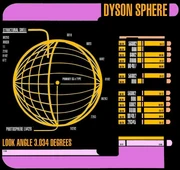
A graphic of a Dyson sphere
Technically speaking, the episode showed a Dyson shell rather than a Dyson sphere. A Dyson sphere – sometimes called a Dyson "swarm" – consists of a series of satellites (or statites) orbiting a star which capture a large portion of its energy output and then transmit that energy to another location (e.g., a planet in the star system), or are themselves space habitats.
The Dyson sphere was named after scientist Freeman Dyson, who envisioned a real-world postulate in 1959, although the actual sphere that Dyson theorized was not a solid object like the one visualized in the episode. Dyson himself, who himself never took his idea too seriously, said in a later interview that, while the science behind it was "nonsense", as TV viewer he enjoyed the episode, [1] More specifically, he called his theory a "joke." About "Relics", Dyson said: "Actually it was sort of fun to watch it. It's all nonsense, but it's quite a good piece of cinema." [2] In the same interview, he said that "Stapledon sphere" would be a more appropriate name, in honor of Olaf Stapledon, whose depiction of such an object in his 1937 novel Star Maker inspired young Dyson to look into the theory.
A Dyson shell would retain all energy produced by the star, and would somehow have to radiate much of this into space to maintain a habitable surface temperature. One possible way of conserving such vast quantities of energy without emitting any visible radiation (as seen on-screen) would be to convert all the energy to mass - essentially using a replicator-like technology to create the many, many, many planets' worth of matter necessary to construct the whole sphere. Another possible way of disposing of such vast quantities of energy without emitting any visible radiation (as seen on-screen) would be to create a colossal gravitational field. If this was the case, it would explain why the Enterprise was jolted suddenly upon leaving warp, and possibly why the Jenolan's distress call went undetected until the Enterprise passed within a very short distance.
Story premise
The concept of the Dyson sphere as a B-story premise, had actually already been circulating among the writing staff for years, but until then the opportunity has never arisen to utilize the notion, "It was something that we were trying to put in for a long time and it became a standing joke.", noted episode Writer Ronald D. Moore. Once "Relics" came up the opportunity finally afforded itself and the episode's Science Consultant Naren Shankar went to work to beef out the concept, "I originally thought the interesting thing would be to make it a partially complete Dyson's Sphere. It ended up being a completed Dyson's Sphere that was uninhabited. When Ron had written about the Dyson's Sphere in the teaser, he wrote "tech" and I gave him the numbers for the size of it. He was shocked that it was so big. It was like the equivalent of four million earths. It's huge. If you build something the size of the sun's orbit, you're talking about a sphere with a diameter of two hundred million miles." (Cinefantastique, Vol. 24, issue 3/4, p. 27)
Dyson Sphere maquettes
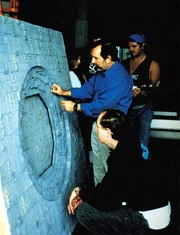
|
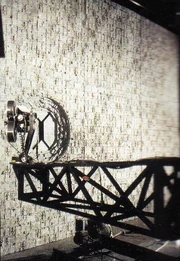
|
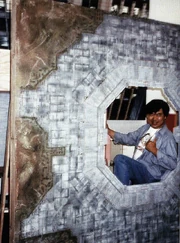
|
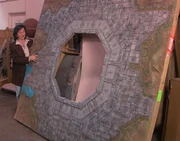
|
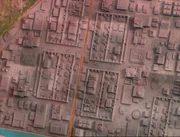
|
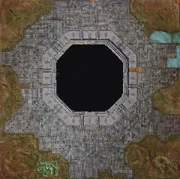
|
For the Star Trek episode, both exterior and interior maquettes were built at Gregory Jein, Inc., while the initial full-sized exterior view and interior long views were executed as matte paintings by Eric Chauvin. (Star Trek: The Next Generation Companion, 3rd ed., p. 220) Episode's visual effects supervisor David Stipes initially wanted to do the exterior approach scene in CGI. He envisioned the Enterprise approaching the sphere from a great distance, and when the sphere grew closer its initial smooth looking surface would resolve into a fantastically detailed network of structures against which the Enterprise would be dwarfed. "It would have been a perfect CGI shot", Stipes enthused, but budgetary considerations made the proposal unfeasible, causing him to sigh at the time, "Contrary to what people are saying about CGI, it's still not as cheap as doing a model" (Cinefantastique, Vol. 24, issue 3/4, p. 80) Stipes later elaborated, "At first we talked about generating it with computers. But we ran into some challenges, so we called in Greg Jein". Still, some use of computer aid was made as Stipes explained, continuing, "But Greg's model was huge. But we needed it to be a hundred feet long to give us the required scale. So the crew shot a selection of the panel and then digitally reproduced that section over and over, in cookie-cutter fashion, making things look like it stretched on for miles."
At his model shop, Jein and his team of modelers at his model shop built two versions of the Dyson sphere surface, an exterior one, actually several of those for assembly into one huge exterior maquette, with one featuring the articulated access door, and an interior one. On constructing the maquettes, Jein recalled,
"The master pattern is made out of sections of a Japanese model kit. We cast them into a larger pattern and then made a rubber mold. Then we peeled it off and started pouring giant urethane bricks. We put the bricks on wooden frames and put the frames together once we got to the stage.(...)The exterior was pretty straight forward, because all the panels were the same except for the door. We had more fun with the interior, because we made it look like an industrial city block. We put our high school names in some of the buildings, like "Dorsey High School", but the audiences never saw that. We used a lot of pieces out of "central casting"–that's what we call our stock molds that have lots of detail in them–to break up the surface so that each panel wasn't exactly the same. I carved the main core around the door out of foam because we didn't have time to make molds; It's sort of free-form." (Star Trek: The Next Generation 365, p. 275)
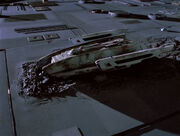
|
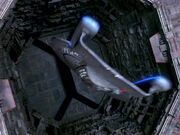
|
Two additional specialty maquettes were constructed for particular close-up scenes, a more detailed enlarged one of the exterior surface to go with with the USS Jenolan studio model in order to depict its crash site, and a detailed interior airlock corridor maquette for close-ups of the escaping USS Enterprise-D. For the interior airlock maquette, Jein and his team used parts and pieces he kept lying around in his model shop as stock. "We used some left over running ship parts to make the corridor from the interior of the Dyson's Sphere to the exterior, so the justification for hoarding all those parts these last 20 odd years finally paid off.", Jein clarified. (Cinefantastique, Vol. 24, issue 3/4, p. 27)
Penny Juday endeavored to give insight into the creation of the interior maquette model by trying to explain the technique of "kitbashing" in the TNG Season 2 DVD-special feature, "Inside Starfleet Archives - Penny Juday, Star Trek Coordinator". According to Juday, the art department produced similar structures on several other occasions, combining them on a large board. Neither the exterior maquette panels nor the two specialty maquettes, were ever sighted again, having more than likely been discarded, as was usual with episode-specific production pieces this large. Against all odds however, the out of resin and plywood constructed interior maquette, measuring 84 inches square, survived long enough to end up in the 40 Years of Star Trek: The Collection auction as Lot 690, estimated at US$800-$1,200, where it sold for US$5,000 ($6,000 including buyer's premium) on 7 October 2006.
Apocrypha
In book #5 of the Double Helix series (Double or Nothing) Captains Calhoun and Picard encounter a Dyson sphere constructed by an anti-Federation alliance. Calhoun and Picard eventually succeed in thwarting the alliance and destroying the sphere.
In the Deep Space Nine Millennium book series, Chief O'Brien is briefly trapped in a Pah-wraith Hell where he is forced to wander the interior of a Dyson sphere for several millennia, unable to understand how the sphere was constructed or learn anything about its creation.
In The Starless World, Kirk and crew encounter a Dyson sphere that surrounds and is controlled by a god-like entity. The sphere has been traveling towards the galactic core for several billion years at sub-light speed and intends to enter a black hole as part of an ancient compact.
In season eight of Star Trek Online, players battle the Voth for control of a Dyson sphere in the Delta Quadrant which formerly belonged to the Solanogen-based lifeforms (referred to as the 'Solanae' in the game) seen in the TNG episode "Schisms". The player also learns that the Dyson sphere encountered by the Enterprise-D in "" (referred to as the Jenolan Dyson sphere) has disappeared without a trace, along with the science team analyzing it. It is later found that both spheres generate and utilize Omega particles to power a form of propulsion for each sphere; this form of propulsion caused the Jenolan Sphere to "jump" further into the Delta Quadrant. In the Season 8.5 episode "A Step Between Stars", the player character and Tuvok rediscover the Jenolan Sphere and the ship studying it while trying to shut down a device on the Solanae Sphere. The rediscovery causes a schism between the Federation, the Klingon Empire and the Romulan Republic and the summit to discuss it allows the Undine to invade Sol.
External links
- Template:NCwiki
- Dyson sphere at Wikipedia
- Dyson spheres in popular culture at Wikipedia
